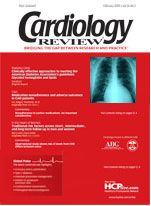AHA issues guidelines for noninvasive testing in women with suspected CAD
The American Heart Association (AHA) has issued a consensus statement to guide physicians in using diagnostic testing for women with suspected coronary artery disease (CAD), including those with diabetes. The statement, published in Circulation (2005;111[4]:682-696), sum-
marizes evidence on the role of commonly used noninvasive testing and also previews emerging technologies.
The consensus panel noted that the diagnosis of CAD in women presents challenges not seen in testing men. Women are less likely than men to have obstructive CAD. Triple-vessel or left-main CAD is more common in men; single-vessel or nonobstructive disease is more common in women, which has resulted in less diagnostic accuracy and higher false-positive rates for women.
Jennifer H. Mieres, MD, committee chair, said the commonly used exercise treadmill electrocardiogram (ECG) is not accurate in all women for diagnosis and risk assessment of CAD. “The key point is they must be able to stay on the treadmill for more than 7 minutes,” she said. “Coronary artery disease usually appears in women 10 to 15 years later than in men. The women we see cannot perform the test adequately because of deconditioning and other comorbid factors.”
The group looked at contemporary cardiac imaging modalities, particularly stress nuclear cardiography (myocardial perfusion imaging) and stress echocardiography, and found that women can be as accurately diagnosed with these techniques as men are, and that these tests are highly accurate. A woman with a normal scan has a low risk for events. Women with abnormal studies on stress echocardiography or stress nuclear imaging should advance to aggressive therapy and catheterization, it recommended.
The statement gave special attention to women with diabetes, which wreaks havoc on the cardiovascular system, and noted that diabetic women may not have the typical symptoms of CAD because of decreased pain perception. According to the panel, “diabetic women merit special consideration and are included in the present statement for cardiac imaging because they have a risk of cardiovascular death that is up to eightfold higher than that of nondiabetic women.”
“The committee decided based on the evidence that diabetic women with suspected CAD, because diabetes is a cardiovascular risk equivalent, should go on to have cardiac imaging,” said Dr. Mieres, director of nuclear cardiology, North Shore University Hospital, Manhassett, New York.
Newer techniques used to identify calcium in the coronary arteries (such as electron beam tomography or multidetector computed tomography) were evaluated. The panel found that widespread screening for calcium is not supported at this time, but in a select group of women who are asymptomatic but have a strong family history of CAD, use of these modalities may be justified. Those with calcium values greater than 400 have a worse prognosis, and the committee recommends aggressive risk modification and further intervention.
Cardiac magnetic resonance imaging (MRI) has the promise to identify subendocardial ischemia, which is not identifiable by other modalities. When a woman has normal epicardial vessels, evaluated with standard noninvasive tests and angiography, but still has symptoms such as chest pain, the greater resolution of cardiac MRI may allow identification of subendocardial disease. The committee said more research is needed in this area.
The committee commented on the body of evidence concerning carotid intima medial thickness and stated that if disease present in the carotid arteries can be easily measured with ultrasound, then this testing modality should be utilized to look for subclinical CAD.
The committee provided an algorithm for risk stratification and diagnosis of CAD in women with suspected disease. It recommends the following:
• Exercise treadmill ECG as the first step for women who can exercise, who can stay on the treadmill for more than 7 minutes, and whose resting ECG is normal.
• Cardiac imaging for women with diabetes or those with decreased functional capacity, using stress echocardiography or stress nuclear cardiography, to accurately identify and detect CAD and to decide who should proceed to catheterization.
